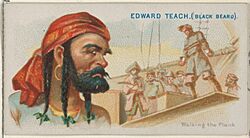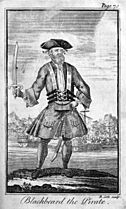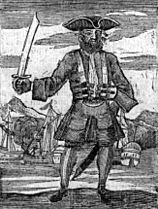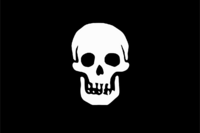Blackbeard facts for kids
Quick facts for kids
Blackbeard
|
|
|---|---|

This drawing of Blackbeard from around 1736 was used in a famous book about pirates.
|
|
| Born |
Edward Teach
c. 1680 |
| Died | (aged 35–40) |
| Cause of death | Killed in action |
| Piratical career | |
| Nickname | Blackbeard |
| Years active | 1716–1718 |
| Rank | Captain |
| Base of operations | |
| Commands | Queen Anne's Revenge, Adventure |
| Battles/wars | Battle of Ocracoke (1718) † |
Edward Teach (or Thatch), born around 1680, is famously known as Blackbeard. He was an English pirate who sailed in the West Indies and along the coast of Britain's American colonies. Not much is known about his early life. He may have been a sailor on privateer ships during Queen Anne's War. Privateers were sailors on private ships hired by a government to attack enemy ships.
Around 1716, Teach joined the crew of the pirate Captain Benjamin Hornigold in The Bahamas. Hornigold soon put Teach in command of his own ship. Together, they captured many vessels. Later, the famous pirate Stede Bonnet joined them. In late 1717, Hornigold retired from piracy.
Teach then captured a large French ship called La Concorde. He renamed it Queen Anne's Revenge and armed it with 40 cannons. With a crew of over 300 men, he became one of the most feared pirates. His nickname came from his long, thick black beard. To scare his enemies, he would tie lit fuses into his beard and under his hat.
Blackbeard created a powerful group of pirates. They once blocked the port of Charles Town, South Carolina, and demanded a ransom. Later, his famous ship, Queen Anne's Revenge, sank after hitting a sandbar. He accepted a royal pardon and settled in Bath, North Carolina. But he soon returned to piracy. This caught the attention of Alexander Spotswood, the governor of Virginia.
Spotswood sent soldiers and sailors to capture Blackbeard. On November 22, 1718, they fought a fierce battle. Blackbeard and many of his crew were killed by sailors led by Lieutenant Robert Maynard.
Blackbeard was a smart leader who preferred to use his scary image rather than violence to get what he wanted. After his death, stories about him made him famous. He became the model for the classic pirate character in books and movies.
Contents
Early Life
Little is known for sure about Blackbeard's early life. He was likely born around 1680, as he was 35 to 40 years old when he died. His name was recorded as Edward Thatch or Edward Teach. Pirates often used fake names to protect their families, so we may never know his real name.
He probably grew up in Bristol, England, which was a major seaport. He knew how to read and write, which was uncommon for sailors at the time. This suggests he may have come from a well-off family. He might have come to the Caribbean on a merchant ship in the late 1600s. Some say he was a privateer from Jamaica during the War of the Spanish Succession.
Life as a Pirate
New Providence: A Pirate's Hideout
The West Indies was a center for trade and piracy in the 17th and 18th centuries. The island of New Providence in The Bahamas became a base for pirates. Its harbor was perfect for their ships but too shallow for large navy vessels. It was a place where pirates could rest and plan their next move safely.
Teach moved to New Providence around 1716. He joined the crew of Captain Benjamin Hornigold, a well-known pirate. Hornigold gave Teach command of a captured ship called a sloop. Together, they captured several ships, taking valuable cargo like flour and wine.
During this time, Teach became a captain in his own right. He met Stede Bonnet, a wealthy landowner who had turned to piracy. Bonnet's crew was unhappy with his leadership, so he let Teach take command of his ship, the Revenge. Their pirate fleet now had three ships. But Hornigold's crew grew tired of him only attacking their old enemies. They voted him out, and he retired. Teach was left in command of the Revenge and another sloop.
Becoming Blackbeard
On November 28, 1717, Teach's ships attacked a French merchant vessel. The ship was La Concorde, which was carrying slaves. Teach captured it and turned it into his flagship. He renamed it Queen Anne's Revenge and fitted it with 40 guns.
Teach's fame grew, and so did his fearsome image. He was described as a "tall spare man with a very black beard which he wore very long." This is how he got his nickname, Blackbeard. He braided his beard into pigtails, tied with ribbons. One writer said he looked more frightening than "a fury from hell."
In battle, he wore a sling with three pistols and stuck lit fuses under his hat. The smoke would surround his face, making him look terrifying. Despite this scary image, there are no records of him ever harming his prisoners.
Growing His Pirate Fleet
By early 1718, Blackbeard and Bonnet were sailing together. They captured a log-cutting sloop called the Adventure near Belize. Teach made one of his trusted men, Israel Hands, the captain. Their fleet grew larger as they captured more ships in the Bay of Honduras.
In May 1718, Blackbeard gave himself the rank of Commodore. He was at the peak of his power. His fleet sailed to Charles Town (now Charleston), South Carolina, and set up a blockade. They stopped any ship trying to enter or leave the port.
The Blockade of Charles Town
For about a week, Blackbeard's fleet captured nine ships near Charles Town. One ship, the Crowley, had important citizens on board, including Samuel Wragg, a member of the Carolina government.
Blackbeard held them as prisoners. He sent a message to the governor demanding medical supplies for his crew. He threatened that if he did not get the supplies, he would execute the prisoners and burn the captured ships.
After some delays, the supplies were delivered. Blackbeard kept his promise. He released the prisoners and their ships, though he took all their valuables first.
Losing His Flagship
After the blockade, Blackbeard heard that the pirate hunter Woodes Rogers was on his way to the West Indies. He sailed his fleet north to an inlet off the coast of North Carolina. He planned to clean the bottoms of his ships there.
On June 10, 1718, the Queen Anne's Revenge hit a sandbar and was badly damaged. Another one of his ships, the Adventure, also ran aground. Both ships were lost. This left Blackbeard with only two vessels. Some believe he wrecked the ships on purpose to shrink his crew and increase his share of the treasure.
A Short-Lived Pardon
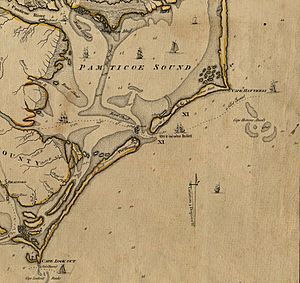
Blackbeard knew the king was offering a pardon to pirates who surrendered. He and Stede Bonnet decided to accept it. Bonnet went to Bath Town and received his pardon from Governor Charles Eden. When he returned, he found that Blackbeard had taken everything of value from his ship, the Revenge, and left his crew on an island. Bonnet went after Blackbeard but never found him. He returned to piracy and was captured and executed.
Blackbeard also went to Bath and received his pardon from Governor Eden in June 1718. He settled down and even got official ownership of his remaining sloop, which he renamed Adventure. But he couldn't stay away from the sea. By August, he was back to piracy.
Attention from Virginia
Blackbeard's return to piracy worried Alexander Spotswood, the governor of Virginia. He saw Blackbeard as a threat to Virginia's trade. Spotswood learned that Blackbeard was hiding out in North Carolina. He believed Governor Eden was not doing enough to stop him.
Spotswood decided to take matters into his own hands. He planned a secret mission to capture Blackbeard. He ordered Captains Gordon and Brand of HMS Pearl and HMS Lyme to travel overland to Bath. Lieutenant Robert Maynard of HMS Pearl was given command of two commandeered sloops, to approach the town from the sea. He also offered a large reward for Blackbeard's capture.
The Final Battle
On the evening of November 21, 1718, Maynard found Blackbeard's ship, the Adventure, anchored near Ocracoke Island. Blackbeard had a smaller crew than usual because many of his men were ashore. He had only about 25 men on board.
At daybreak, Maynard's two sloops sailed toward the Adventure. Blackbeard's crew spotted them and opened fire. A fierce battle began. Blackbeard tried to sail into a narrow channel, but his ship ran aground.
Maynard's ships were hit hard by Blackbeard's cannons. One sloop was so damaged it couldn't continue the fight. Maynard had lost many of his men. He ordered the rest of his crew to hide below deck, hoping to trick Blackbeard.

Thinking he had won, Blackbeard led his men to board Maynard's ship. As they climbed aboard, Maynard's hidden sailors burst out from the hold. The pirates were caught by surprise.
The two groups fought on the deck. Maynard and Blackbeard faced each other. They both fired their pistols. Maynard hit Blackbeard, but the pirate fought on with his cutlass. Just as Blackbeard was about to strike a final blow, one of Maynard's men wounded Blackbeard, who was then quickly surrounded and killed. The remaining pirates surrendered.
Maynard later examined Blackbeard's body. He found it had been shot five times and cut about twenty times. Blackbeard's head was cut off and hung from the front of Maynard's sloop to prove he was dead and to collect the reward.
The prize money for capturing Teach was to have been about £400 (£56,000 in 2025) , but it was split between the crews of HMS Lyme and HMS Pearl. As Captain Brand and his troops had not been the ones fighting for their lives, Maynard thought this extremely unfair. He lost much of any support he might have had though when it was discovered that he and his crew had helped themselves to about £90 of Teach's booty. The two companies did not receive their prize money for another four years, and despite his bravery Maynard was not promoted, and faded into obscurity.
The remainder of Teach's crew and former associates were found by Brand, in Bath, and were transported to Williamsburg, Virginia, where they were jailed on charges of piracy. They were hanged along Williamsburg's Capitol Landing Road (known for some time after as "Gallows Road").
Legacy
Although he was a famous pirate, Blackbeard was not the most successful. Others, like Bartholomew Roberts, stole much more. People have searched for Blackbeard's legendary buried treasure, but none has ever been found that can be linked to him. Most stories of buried pirate treasure are myths.
In 1996, researchers found the wreck of what is believed to be the Queen Anne's Revenge. Thousands of artifacts have been recovered from the site. Many are on display at the North Carolina Maritime Museum.
Blackbeard's story has inspired countless books, movies, and even amusement park rides. Much of what we know comes from a 1724 book called A General Historie of the Robberies and Murders of the Most Notorious Pyrates. This book made Blackbeard and other pirates like Anne Bonny and Mary Read famous.
Today, Blackbeard is the image of the classic pirate: fearsome, daring, and adventurous. His legend continues to capture the imagination of people all over the world.
See also
 In Spanish: Barbanegra para niños
In Spanish: Barbanegra para niños


